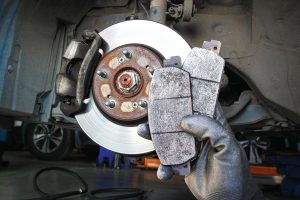When it comes to vehicle safety, your brake system is one of the most critical components — and at the heart of that system are your brake pads. Although small in size, brake pads play a huge role in how effectively your car stops. One major factor that determines their performance is thickness.
In this article, we’ll explore why brake pad thickness matters, how it affects performance, the warning signs of wear, and most importantly — when to replace them.
Why Brake Pad Thickness Matters

Brake pads function by applying pressure and friction to the brake rotors when you press the brake pedal. As they do this, the friction material on the pads gradually wears down. The thinner the pad gets, the less effective it becomes, and the more heat it generates, potentially damaging other parts of the braking system.
Effects of Reduced Brake Pad Thickness:
| Brake Pad Thickness | Braking Performance | Safety Risk |
|---|---|---|
| 10–12 mm (new) | Optimal braking power | Minimal |
| 6–9 mm | Still safe, minor wear | Low |
| 3–5 mm | Reduced effectiveness | Medium |
| 1–2 mm or less | Dangerously ineffective | High |
What Is the Minimum Brake Pad Thickness?
Most manufacturers and mechanics recommend replacing brake pads when the friction material is 3 mm or less. Waiting until they’re completely worn down increases the risk of:
-
Longer stopping distances
-
Heat-damaged rotors
-
Brake fluid boiling (brake fade)
-
Brake failure in extreme cases
General Replacement Guidelines:
| Driving Type | Recommended Thickness for Replacement |
|---|---|
| City driving (frequent stops) | ~3–4 mm |
| Highway driving (light braking) | ~2–3 mm |
| Heavy loads/towing | 4–5 mm to maintain safe margins |
How Thin Brake Pads Affect Performance
1. Increased Stopping Distance
Thin pads mean less friction material to absorb heat, making it harder for your vehicle to stop quickly — especially during emergency braking.
2. Overheating & Brake Fade
Thin brake pads can’t dissipate heat effectively. This leads to brake fade, where the braking power temporarily drops and the pedal may feel soft or spongy.
3. Damage to Rotors
When pads are too thin, the metal backing plate may contact the rotor directly, causing grooves or warping — a costly repair.
4. Noise and Vibration
Squealing, grinding, or vibrating brakes are often a sign of worn-down pads. At this point, both performance and comfort are compromised.
How to Measure Brake Pad Thickness
There are several ways to check brake pad wear:
-
Visual Inspection: Look through the wheel spokes or remove the wheel. New pads are about 10–12 mm thick.
-
Digital Caliper Tool: Accurate measurement to within 0.1 mm.
-
Built-in Wear Indicator: Many pads have a small metal tab that squeals when the pad is too thin.
-
Brake Warning Light (in modern cars): If illuminated, the sensor has detected unsafe wear.
DIY Tip: Always measure both inner and outer pads. Uneven wear can indicate caliper issues.
When to Replace Your Brake Pads
Here are some key signs it’s time for a replacement:
Common Warning Signs
-
Squealing or grinding noises when braking
-
Longer stopping distances
-
Brake pedal feels soft or vibrates
-
Visible pad thickness under 3 mm
-
Dashboard brake light warning
Brake Pad Maintenance Tips
To get the most life and performance from your brake pads:
Maintenance Checklist
-
Check pad thickness every 10,000–15,000 km
-
Replace pads before reaching 2–3 mm
-
Avoid hard, sudden braking when unnecessary
-
Don’t delay brake service if you hear grinding
-
Use high-quality pads suitable for your vehicle type and driving style
Brake Pad Lifespan by Type
| Pad Type | Average Lifespan (km) | Performance |
|---|---|---|
| Organic | 30,000 – 50,000 | Quiet, low dust |
| Semi-metallic | 50,000 – 80,000 | High durability |
| Ceramic | 70,000 – 100,000 | Clean, quiet, long life |
Not all brake pads are created equal. Always choose a set that matches:
-
Your vehicle’s braking system
-
Driving habits (city, highway, aggressive)
-
The load (heavy-duty, towing, etc.)
Whether you’re driving daily or hauling loads, a well-matched brake pad can make all the difference in safety and performance.
Buy Brake Pads online to ensure quality, compatibility, and peace of mind.
Final Thoughts
Brake pads may be small, but their impact on safety is massive. Monitoring brake pad thickness and replacing them before they’re too thin ensures reliable braking, avoids costly repairs, and most importantly — keeps you safe on the road.
Stay ahead of wear, and never underestimate the importance of a few millimeters.
